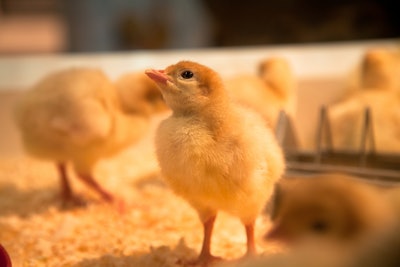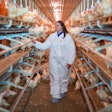
Having chicks hatch on the farm with immediate access to food and water could reduce stress and result in better broiler performance.
“In addition, it eliminates a couple stressors so that there is no chicks having to be held anymore,” Erik Hoeven, general manager, NestBorn, said at the 2023 Poultry Tech Summit. “And there’s also no transport of the day-old chicks anymore. That doesn’t exist when you use on-farm hatching.”
At a traditional hatchery, eggs undergo 18 days of incubation and they stay at the hatchery for an additional three days after hatching before the chicks are moved to the farm.
However, with on-farm hatching, pre-incubated eggs are shipped to a broiler farm, where they are hatched directly on the floor. This can occur either by a robot transferring the eggs from flats onto the litter or by placing the eggs on degradable pulp trays directly onto the floor of the farm. Either way, chicks hatched on-farm receive uninterrupted early access to feed and water and an elimination of handling and transport stressors.
Benefits of on-farm hatching
Chicks hatched on the farm show lower mortality and less footpad dermatitis. In addition, early research suggests that the system results in increased hatchability with fewer hatchery culls.
On-farm hatching can also have sustainability benefits, including needing a smaller footprint and a lower capital investment in equipment, up to 40% lower energy use and 80% lower water use and fewer breeders.
However, one of the largest is the flexibility it gives to the poultry supply chain, Hoeven explained.
Farmers can choose when to begin incubating the eggs on the farm, which allows them to “better serve the processing plants because you have these chicks being born any time of the week as desired,” he added.



















